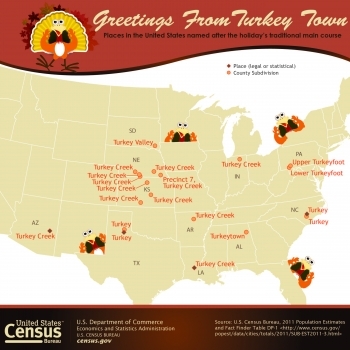Nov262014
Posted at 11:15 AM
In the fall of 1621, the Pilgrims — early settlers of Plymouth Colony, held a three-day feast to celebrate a bountiful harvest. This event is regarded by many as the nation’s first Thanksgiving. The Wampanoag Indians in attendance played a key role. Historians have recorded ceremonies of thanks among other groups of European settlers in North America. These include the British colonists in Virginia as early as 1619.
The legacy of thanks and the feast have survived the centuries, as the event became a national holiday 151 years ago (Oct. 3, 1863) when President Abraham Lincoln proclaimed the last Thursday of November as a national day of thanksgiving. Later, President Franklin Roosevelt clarified that Thanksgiving should always be celebrated on the fourth Thursday of the month to encourage earlier holiday shopping, never on the occasional fifth Thursday.
The U.S. Census Bureau today released key statistics in honor of Thanksgiving and the holiday season.
- There were 242 million turkeys forecasted to be raised in the United States in 2014.
- Minnesota was the leading state in the number of turkeys raised with 45 million in 2014 followed by North Carolina (35 million), Arkansas (29 million), Indiana (17 million), Missouri (17 million), and Virginia (16 million).
- 856 million pounds of cranberries were produced in the U.S. in 2014. Wisconsin was estimated to lead all states in the production of cranberries, with 538 million pounds, followed by Massachusetts (estimated at 210 million). New Jersey, Oregon and Washington were also estimated to have substantial production, ranging from 16 to 55 million pounds.
- 2.4 billion pounds of sweet potatoes — another popular Thanksgiving side dish — were produced in the U.S. in 2014.
For more information and other key statistics on Thanksgiving, please go to the latest issue of the Census Bureau's Facts for Features.




